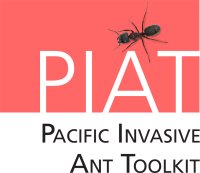Sticky traps
The sticky trap method uses a sticky compound or sticky tape. They are not used very frequently, and we have not heard that this is a particularly useful approach, so we have included it here for completeness only. If you work on invasive ants and find these are useful please let us know.
Tanglefoot is the standard trapping compound used for this type of sampling. The product is available in either a sticky paste, which needs to be applied with a spatula or in a less sticky brushable form. Tanglefoot is non-toxic and is marketed as environmentally friendly.
Comparable results have been described using double-sided foam tape attached to the tree.
Tree sampling
The Tanglefoot compound is spread thinly over a strap of 2.5 cm wide grease-proof tape stapled to the trunks of trees along a 100 X 5 m transect.
Care must be taken on rough barked trees that there is no space under the tape for ants to crawl though. This can be done by securing the tape tightly over a layer of cotton wool, soft fabric or tissue (e.g. toilet tissue).
Ground sampling
|
Sticky trap sampling may also be used for sampling ants that live or forage on the ground. This method uses double sided tape and an attractive lure such as jam, tuna or peanut butter. The centre of a 120 mm strip of 15 mm double sided tape is spread with jam, tuna or peanut butter. The tape is then placed inside a 150 mm length of clear plastic tube with a 25 mm internal diameter. The traps are placed along a transect at 20 m intervals. Another ground sticky trap method is the Detto sticky trap. This trap is composed of two metal pieces which together form a box. A piece of sticky board is placed inside the box, with a small square of sponge attached to it. The attractive lure (i.e. cat food, jam, etc.) is squirted into the sponge. |
The Detto sticky trap. On the right is the assembled trap. The two component pieces are on the left, including the sticky board and sponge (© Wet Tropics Management Authority) |
The small diameter of the holes (5 mm) on the side of this trap will prevent larger invertebrates, and vertebrates, from entering the lure. These traps may also be used as bait stations for bait distribution. For information on creating your own Detto sticky traps, please contact the Wet Tropics Management Authority.
Information sources
Charles, Suckling, Allan, Froud, Dentener, Connolly, Verberne. 2002. The distribution of Argentine ant in New Zealand: can a ten-year old decision not to eradicate be re-visited? In Goldson, Suckling (eds.) Defending the green oasis: New Zealand biosecurity and Science. Proceedings of a New Zealand Plant Protection Society Symposium pp.153: 109-224
Majer. 1990. The abundance and diversity of arboreal ants in Northern Australia. Biotropica 22(2): 191-199.
Southern Monitoring Services Limited New Zealand
Entosupplies Australia
Chris Clerc, Wet Tropics Management Authority and Lori Lach, James Cook University
content reviewed by Phil Lester, Victoria University of Wellington, August 2016

